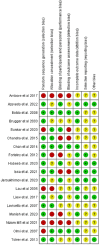Glue versus tackers for mesh fixation in laparoscopic inguinal hernia repair: a meta-analysis and trial sequential analysis
- PMID: 40186768
- PMCID: PMC11972183
- DOI: 10.1007/s10029-025-03315-w
Glue versus tackers for mesh fixation in laparoscopic inguinal hernia repair: a meta-analysis and trial sequential analysis
Abstract
Purpose: Mesh fixation in laparoscopic inguinal hernia repair has improved patient outcomes compared to natural tissue repair. The method of fixation of the mesh to the abdominal wall and its impact on patient outcomes has not been determined as part of a trial sequential analysis. The aim of this study is to compare the use of glue and tackers in mesh fixation of inguinal and femoral hernia repair by meta-analysis and trial sequential analysis (TSA).
Method: Medline, Cochrane Library, Scopus, Web of Science, and EMBASE were searched to retrieve relevant randomised controlled trials (RCT) comparing glue and tacker fixation in laparoscopic inguinal and femoral hernia repair, resulting in 648 studies, of which 18 met the inclusion criteria. This data was systematically analysed using RevMan and TSA software.
Results: 2312 patients were included in the 18 RCTs used in this study, with 1149 in the glue cohort and 1163 in the tacker cohort. Glue fixation significantly reduced risk of haematoma formation [MD (95% CI): 0.35 (0.17-0.73), P < 0.01]. Glue fixation resulted in significantly less acute pain [MD (95% CI): - 1.80 (- 2.71 to - 0.89), P < 0.01] and chronic pain [MD (95% CI): 0.42 (0.27-0.64), P < 0.01]. Glue fixation also allowed significantly quicker return to normal activity/work compared to tacker fixation [MD (95% CI): - 1.92 (- 3.17 to - 0.67), P < 0.01]. TSA confirmed that glue fixation significantly reduced early pain scores (< 3 months) and haematoma incidence compared to tacker fixation.
Conclusion: Mesh fixation with glue is superior to tackers in reducing post-operative pain and haematomas, which means patients return to work/activity significantly faster. Surgeons should be aware of these benefits when consenting the patient for laparoscopic inguinal and femoral hernia repair.
Keywords: Fibrin; Glue; Hernia; Laparoscopic; Mesh; Tackers.
© 2025. The Author(s).
Conflict of interest statement
Declarations. Conflict of interest: The authors declare that they have no conflict of interest. Ethical approval: Not required. Human and animal rights: This article does not contain any studies with human participants or animals performed by any of the authors. Informed consent: For this type of study formal consent is not required.
Figures







Similar articles
-
Glue versus mechanical mesh fixation in laparoscopic inguinal hernia repair: meta-analysis and trial sequential analysis of randomized clinical trials.Br J Surg. 2021 Jan 27;108(1):14-23. doi: 10.1093/bjs/znaa002. Br J Surg. 2021. PMID: 33640918
-
Mesh fixation with fibrin glue versus tacker in laparoscopic totally extraperitoneal inguinal hernia repair.ANZ J Surg. 2021 Oct;91(10):2086-2090. doi: 10.1111/ans.17165. Epub 2021 Aug 27. ANZ J Surg. 2021. PMID: 34448342 Clinical Trial.
-
A meta-analysis of randomized control trials assessing mesh fixation with glue versus suture in Lichtenstein inguinal hernia repair.Medicine (Baltimore). 2018 Apr;97(14):e0227. doi: 10.1097/MD.0000000000010227. Medicine (Baltimore). 2018. PMID: 29620633 Free PMC article.
-
Efficacy and safety of glue mesh fixation for laparoscopic inguinal hernia: A meta-analysis of randomized controlled trials.Asian J Surg. 2023 Sep;46(9):3417-3425. doi: 10.1016/j.asjsur.2023.03.146. Epub 2023 Apr 8. Asian J Surg. 2023. PMID: 37037745 Review.
-
Fibrin glue versus staple for mesh fixation in laparoscopic transabdominal preperitoneal repair of inguinal hernia: a meta-analysis and systematic review.Surg Endosc. 2017 Feb;31(2):527-537. doi: 10.1007/s00464-016-5039-y. Epub 2016 Jun 28. Surg Endosc. 2017. PMID: 27351657
Cited by
-
Comment to: Glue versus tackers for mesh fixation in laparoscopic inguinal hernia repair : Kitching S, et al. Glue versus tackers for mesh fixation in laparoscopic inguinal hernia repair: a meta-analysis and trial sequential analysis. Hernia. 2025;29(1):134 [preprint].Hernia. 2025 May 15;29(1):165. doi: 10.1007/s10029-025-03349-0. Hernia. 2025. PMID: 40374953 No abstract available.
-
Efficacy of intraperitoneal positive pressure gas expulsion in laparoscopic transabdominal preperitoneal hernioplasty: a retrospective cohort study.BMC Surg. 2025 May 27;25(1):231. doi: 10.1186/s12893-025-02965-y. BMC Surg. 2025. PMID: 40426184 Free PMC article.
References
-
- Lundström K-J, Holmberg H, Montgomery A, Nordin P (2018) Patient-reported rates of chronic pain and recurrence after groin hernia repair. Br J Surg 105:106–112. 10.1002/bjs.10652 - PubMed
-
- Kumar S, Wilson RG, Nixon SJ, Macintyre IMC (2002) Chronic pain after laparoscopic and open mesh repair of groin hernia. BJS (Br J Surg) 89:1476–1479. 10.1046/j.1365-2168.2002.02260.x - PubMed
-
- Öberg S, Andresen K, Rosenberg J (2018) Decreasing prevalence of chronic pain after laparoscopic groin hernia repair: a nationwide cross-sectional questionnaire study. Surg Today 48:796–803. 10.1007/s00595-018-1664-5 - PubMed
-
- Jourdan IC, Bailey ME (1998) Initial experience with the use of N-butyl 2-cyanoacrylate glue for the fixation of polypropylene mesh in laparoscopic hernia repair. Surg Laparosc Endosc 8:291–293 - PubMed
Publication types
MeSH terms
Substances
LinkOut - more resources
Full Text Sources
Research Materials
Miscellaneous

